Stratiomyidae
Soldier flies
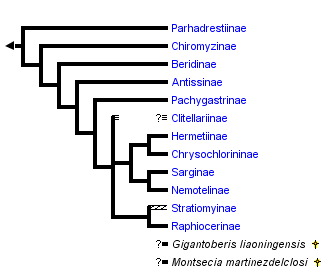


This tree diagram shows the relationships between several groups of organisms.
The root of the current tree connects the organisms featured in this tree to their containing group and the rest of the Tree of Life. The basal branching point in the tree represents the ancestor of the other groups in the tree. This ancestor diversified over time into several descendent subgroups, which are represented as internal nodes and terminal taxa to the right.

You can click on the root to travel down the Tree of Life all the way to the root of all Life, and you can click on the names of descendent subgroups to travel up the Tree of Life all the way to individual species.
For more information on ToL tree formatting, please see Interpreting the Tree or Classification. To learn more about phylogenetic trees, please visit our Phylogenetic Biology pages.
close boxIntroduction
Stratiomyidae, the soldier flies, are a diverse family of orthorrhaphous Brachycera. Though they exhibit great morphological variation, the family is distinct from other flies due to their unique wing venation and larval habitus (fig. 2). Larval habitats are varied; several are aquatic filter feeders (Stratiomys, Odontomyia), others live in madicolous habitats; on stones with a thin film of running water (some Oxycera); some of the aquatic larvae can tolerate high levels of salinity (some Nemotelus) or high temperature (some Stratiomys); others are terrestrial and saprophagous or sarcophagous (e.g. Hermetia), or live under bark (Pachygastrinae), or in ant nests (some Clitellaria). Three species of Chiromyzinae are herbivorous agricultural pests. The adults are most often collected on foliage in damp forests, near bodies of water, or near boggy areas (James 1981). Many genera, particularly in the Stratiomyinae and Nemotelinae, visit flowers. Some soldier flies exhibit interesting mating behaviors, such as Hermetia pterocausta which leks, and males of many species, including some Beridinae, Pachygastrinae and Microchrysa, form large mating swarms (Woodley 2001).
There are 375 extant genera of Stratiomyidae, arranged in 12 subfamilies. Pachygastrinae has the most genera, but many of these are monotypic. Stratiomyinae has the greatest number of described species as it includes the speciose genera Odontomyia and Stratiomys. The Neotropical Region contains the highest stratiomyid species diversity of all the biogeographic regions.
Grimaldi and Cumming (1999) hypothesize that the most recent common ancestor of all Stratiomyidae flew 150 mya. Oligocene fossils are known for Stratiomys, Odontomyia, and Cyphomyia (Brammer and von Dohlen 2007).
Characteristics
The monophyly of Stratiomyidae is well supported as the family is morphologically distinctive. Morphological synapomorphies of the 'groundplan' soldier fly according to Woodley (2001) and Brammer and von Dohlen (2007) include:
- Female cerci separated by abdominal tergite 10.
- Radial veins placed far anteriorly, near costal margin of wing (fig. 1).
- Discal cell rounded and reduced in size (fig. 1).





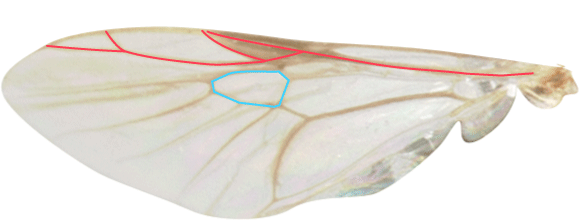
Figure 1. Wing of Adoxomyia subulata. Radial veins highlighted in red; discal cell blue. © Keith Bayless
The hypothesized plesiomorphic morphological condition in soldier flies is 8 antennal flagellomeres and a more complete wing venation. These features are not present in Parhadrestiinae, however, as they have fused flagellomeres and somewhat reduced venation (Woodley 2001). Adults can range in size from 3 to 30 mm. The number of scutellar spines, number and morphology of antennal flagellomere segments, and presence or absence of certain wing veins are often used to distinguish subfamilies.
The larva is dorsoventrally flattened, with a triangular shaped head. Its cuticle contains hexagonal calcium carbonate crystals, offering protection and giving it an unusual looking texture (fig. 2). The best known soldier fly, Hermetia illucens, has six larval instars, but other soldier flies may have 7-10 larval instars (Rozkošný 1998).


Figure 2. Larva of Stratiomys sp. © Perry Babin
Relationship of Stratiomyidae to Other Brachycera
Stratiomyidae is the largest family in the infraorder Stratiomyomorpha. Its phylogenetic position in relation to the other families in the infraorder is not corroborated in all studies. Woodley (1989) posited that the sister group of Stratiomyidae is Xylomyidae, based on the following morphological characters:
- Pupation in the last larval integument.
- Larval cuticle encrusted with calcium carbonate.
- Lack of prothoracic and mesothoracic tibial spurs.
- Costal vein abbreviated.
Yeates (2002) recognized 10 morphological synapomorphies uniting Stratiomyidae and Xylomyidae but only 5 uniting Pantophthalmidae with these to form the clade recognized as the infraorder Stratiomyomorpha (Yeates 2002; Yeates and Wiegmann 1999). However, using nucleotide sequence data, Wiegmann et al. (2003) found Stratiomyidae as sister to Pantophthalmidae + Xylomyidae, and combined analysis of molecular and morphological evidence supports monophyly for the Stratiomyomorpha and for the pantophthalmids as sister to the Statiomyidae+Xylomyidae (Wiegmann et al. 2003; Yeates and Wiegmann 2005).
Discussion of Phylogenetic Relationships
A possible stem-group stratiomyiomorph or stratiomyid fly, Gigantoberis liaoningensis, was described in 2006 (Huang & Lin 2006), but the identity of the fossil and its phylogenetic placement deserve scrutiny. Woodley (1986) established Parhadrestiinae and demonstrated its sister group relationship to all other soldier flies. The two most recent phylogenetic analyses of Stratiomyidae are those of Woodley (2001) using morphological evidence and Brammer and von Dohlen (2007) using molecular data. The topologies of the trees resulting from those two studies are largely congruent. The differences between Woodley's (2001) tree and that depicted here are the placement of Pachygastrinae, Nemotelinae, and Chrysochlorininae. Woodley's (2001) analysis places Pachygastrinae in a polytomy together with Clitellariinae, a clade consisting of Hermetiinae,(Chrysochlorininae,Sarginae) and a clade consisting of Stratiomyinae, Raphiocerinae, and Nemotelinae. Brammer and von Dohlen's (2007) analysis breaks up Clitellariinae, placing clitellarine taxa throughout the tree. Information about lternative phylogenetic placements for some stratiomyid genera can be found on their respective subfamily or genus page in the tolweb.org phylogenetic hierarchy.
References
Brammer, C.A. and C.D. von Dohlen. 2007. The evolutionary history of Stratiomyidae (Insecta: Diptera): the molecular phylogeny of a diverse family of flies. Mol. Phylogenet. Evol. 43:660-73.
Grimaldi, D. and J. Cumming. 1999. brachyceran Diptera in Cretaceous ambers and Mesozoic diversification of the Eremoneura Bull. Am. Mus. Nat. Hist. 239:1-121.
Huang, D. and Q. Lin. 2006. A new soldier fly (Diptera, Stratiomyidae) from the Lower Cretaceous of Liaoning Province, northeast China. Cretac. Res. 28:317-321.
James, M.T. 1965. Contributions to our knowledge of the Nearctic Pachygasterinae (Diptera: Stratiomyidae). Ann. Entomol. Soc. Am. 58:902-908.
James, M.T. 1965. Family Stratiomyidae. Pp.299-319, in Stone, A., C. Sabrosky, W. Wirth, R. Foote, J. Coulson. A catalog of the Diptera of America north of Mexico. Agricultural Research Service, USDA, IIV, 1-1696.
James, M.T. 1977. The Pachygastrine Genera Lenomyia, Dialampsis, Aidomyia, Adraga, Eupachygaster, and Pegadomyia in New Guinea and the Bismarck Archipelago (Diptera: Stratiomyidae). Pacific Insects 17:473-488.
James, M.T. 1981. 36. Stratiomyidae. Manual Nearct. Dipt. 1: 497-511.
Oosterbroek, P. 1998. 33. Stratiomyidae (Soldier Flies). In P. Oosterbroek: The families of Diptera of the Malay Archipelago. Brill: Boston. pp. 88-89.
Rozkošný, R. 1982. A biosystematic study of the European Stratiomyidae (Diptera). Volume 1. Introduction, Beridinae, Sargunae, and Stratiomyinae. Dr. W. Junk, The Hague, Boston 1-401.
Rozkošný, R. 1998. Chapter 24. Family Stratiomyidae. Manual Palaearct. Dipt. 2: 387-411.
Wiegmann, B.M., D.K. Yeates, J.L. Thorne, and H. Kishino. 2003. Time flies, a new molecular time-scale for brachyceran fly evolution without a clock. Syst. Biol. 52:745–756.
Woodley, N.E. 1986. Parhadrestiinae, a new subfamily for Parhadrestia James and Cretaceogaster Teskey (Diptera: Stratiomyidae). Syst. Entomol. 11:377-387.
Woodley, N. E. 1995. The genera of Beridinae (Diptera: Stratiomyidae). Memoirs of Entomol. Soc. Wash. 16 1-231.
Woodley, N. E. 2001. A World Catalog of the Stratiomyidae (Insecta: Diptera). Myia 11: 1-473. Backhuys Publishers, Leiden.
Yeates, D. K. 2002. Relationships of the lower Brachycera(Diptera): A quantitative synthesis of morphological characters. Zool. Scr. 31: 105-121.
Yeates, D. K. and B. M. Wiegmann. 2005. Phylogeny and evolution of DIptera: Recent insights and new perspectives, chapter 2 in Yeates, D. K. and B. M. Wiegmann, eds. The Evolutionary Biology of Flies, Columbia University Press, New York.
Yeates, D. K., B. M. Wiegmann, G. W. Courtney, R. Meier, C. Lambkin, and T. Pape. 2007. Phylogeny and systematics of Diptera: Two decades of progress and prospects. Zootaxa 1668:565-590.
Information on the Internet
- Bugguide.net. Images of, an information about Stratiomyidae.
- Diptera.info. Images of Stratiomyidae.
- Science Direct- Huang & Lin 2006. Description of Gigantoberis liaoningensis.
- Web catalogue of the fossil flies. Catalogue of fossil soldier flies.
- Harvard University Museum of Comparative Zoology. Soldier fly type image database.
- Australasian/Oceanian Diptera Catalog. Stratiomyidae of the Australian and Oceanian Region.
Title Illustrations

| Scientific Name | Hoplitimyia constans |
|---|---|
| Location | Fayetteville, Washington County, Arkansas, USA |
| Specimen Condition | Live Specimen |
| Identified By | Norman Woodley |
| Life Cycle Stage | Adult |
| Size | 12 mm |
| Source Collection | BugGuide.Net |
| Image Use |
 This media file is licensed under the Creative Commons Attribution-NonCommercial-NoDerivs License - Version 1.0. This media file is licensed under the Creative Commons Attribution-NonCommercial-NoDerivs License - Version 1.0.
|
| Copyright |
© Edward Trammel

|
| Scientific Name | Odontomyia sp. |
|---|---|
| Location | Del Puerto Canyon, California, USA |
| Identified By | Norman Woodley |
| Source | Stratiomyidae- Soldier Fly |
| Copyright |
© 2003 Alex Wild

|
About This Page
Page copyright © 2008
All Rights Reserved.
- First online 05 September 2004
- Content changed 29 September 2008
Citing this page:
Tree of Life Web Project. 2008. Stratiomyidae. Soldier flies. Version 29 September 2008 (under construction). http://tolweb.org/Stratiomyidae/10444/2008.09.29 in The Tree of Life Web Project, http://tolweb.org/




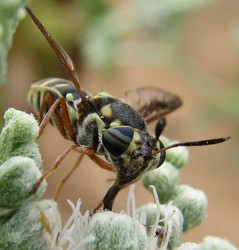
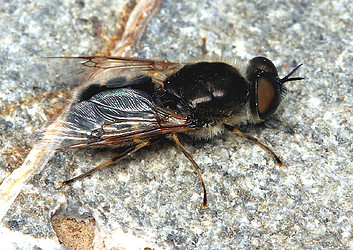

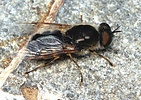

 Go to quick links
Go to quick search
Go to navigation for this section of the ToL site
Go to detailed links for the ToL site
Go to quick links
Go to quick search
Go to navigation for this section of the ToL site
Go to detailed links for the ToL site